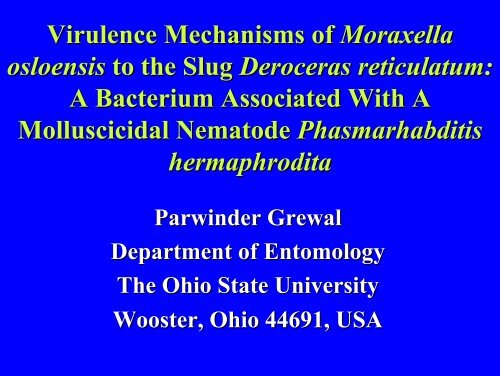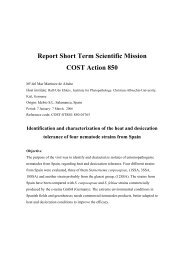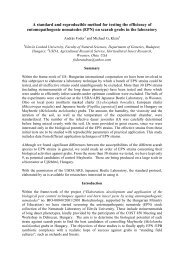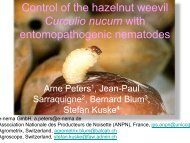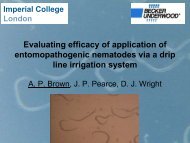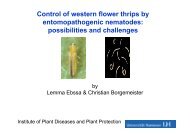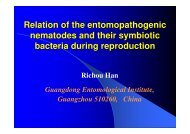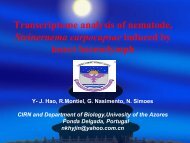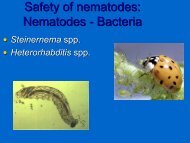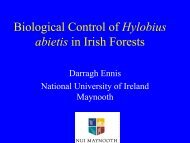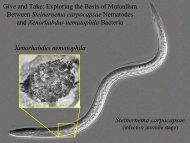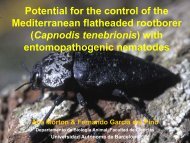Virulence Mechanisms of Moraxella osloensis to ... - COST Action 850
Virulence Mechanisms of Moraxella osloensis to ... - COST Action 850
Virulence Mechanisms of Moraxella osloensis to ... - COST Action 850
- No tags were found...
Create successful ePaper yourself
Turn your PDF publications into a flip-book with our unique Google optimized e-Paper software.
<strong>Virulence</strong> <strong>Mechanisms</strong> <strong>of</strong> <strong>Moraxella</strong><strong>osloensis</strong> <strong>to</strong> the Slug Deroceras reticulatum:A Bacterium Associated With AMolluscicidal Nema<strong>to</strong>de PhasmarhabditishermaphroditaParwinder GrewalDepartment <strong>of</strong> En<strong>to</strong>mologyThe Ohio State UniversityWooster, Ohio 44691, USA
Slug DamageLeft:D. laeve biting a berry (Regents, University <strong>of</strong> California);Right:D. reticulatum damage <strong>to</strong> corn (pho<strong>to</strong> by M. Rice).
Slug-Parasitic Nema<strong>to</strong>de:Phasmarhabditis hermaphroditaInfective juvenile <strong>of</strong> P.hermaphrodita: two layers <strong>of</strong> cuticle. closed mouth andanus. Size: about 1 mmlong, 40 µm m bodydiameter.
Host Range <strong>of</strong> P.hermaphroditaSlugsSnailsArion aterCernuella virgataA. distinctusCochlicella acutaA. intermediusHelix aspersaA. lusitanicusLymnaea stagnalisA. silvaticusMonacha cantianaDeroceras caruanaeTheba pisanaD. laeveD. reticulatumLeidyula floridanaTandonnia budapestensisT. sowerbyi-from Glen and Wilson (1997); Speoser et al. (2001); Grewal et al. (2003).
Left: D. reticulatum infected with P. hermaphrodita.Right: Healthy D. reticulatum. . Note the swollen mantle<strong>of</strong> the infected slug (pho<strong>to</strong> by R. Harvey).
Parasitic Cycle <strong>of</strong> P. hermaphroditaSlug mantleInfective juvenile (IJ) HermaphroditeSlug dies in 7 –14 days
Bacteria associated with P. hermaphroditaFamilyAeromonadaceaeBacillaceaeEnterobacteriaceaeFlavobacteriaceae<strong>Moraxella</strong>ceaePseudomonadaceaeSphingobacteriaceaeSpeciesAeromonas hydrophilaAeromonas sp.Bacillus cereusProvidencia rettgeriSerratia proteamaculansFlavobacterium breveF. odoratum<strong>Moraxella</strong> <strong>osloensis</strong>Pseudomonas fluorescens (isolate no. 1a)P. fluorescens (isolate no. 140)P. fluorescens (isolate no. 141)P. paucimobilisSphingobacterium spiri<strong>to</strong>vorum-from Wilson et al. (1995).
<strong>Moraxella</strong> <strong>osloensis</strong> is a gram-negativeaerobic bacterium. is considered as anopportunistic humanpathogen. is preferred bacteriumfor mass-producingP.hermaphrodita.
Is M. <strong>osloensis</strong> vec<strong>to</strong>red in<strong>to</strong> the shellcavity pathogenic <strong>to</strong> the slug? Wilson et al. (1995) reported that a 24-hrculture <strong>of</strong> M. <strong>osloensis</strong> injected in<strong>to</strong> D.reticulatum hemocoel was not pathogenic. Shell cavity in the posterior mantle region <strong>of</strong> D.reticulatum serves as the main portal <strong>of</strong> entryfor P. hermaphrodita (Tan and Grewal, 2001a). Important organs, including kidney, lung andheart, are located in the slug mantle region.
Pathogenicity <strong>of</strong> 60-hrM. <strong>osloensis</strong> culture <strong>to</strong> D.reticulatum after injection in<strong>to</strong> the shell cavity% slug mortality100806040200 (Control) 6.006.15 × 10 2 6.15 × 10 46.15 × 10 6 6.15 × 10 8R 2 = 0.54*R 2 = 0.73***** ***01 4 8 12Days after injection
% slug motality10080604020Pathogenicity <strong>of</strong> M. <strong>osloensis</strong> cultures <strong>of</strong>different ages against D. reticulatum afterinjection in<strong>to</strong> the hemocoel0aSaline (Control)24 hr culture40 hr culture60 hr culturebaaaaab4 8 12 16Days after injectionaaabbR 2 = 0.66aababb
Effect <strong>of</strong> coinjection <strong>of</strong> penicillin andstrep<strong>to</strong>mycin with 60-hrM. <strong>osloensis</strong> culture onthe bacterial pathogenicity <strong>to</strong> D. reticulatum% slug mortality10080604020aSalineAntibioticsBacteriaBacteria+Antibioticscabbababcaababaabab01 4 8 12Days after infection
Numbers <strong>of</strong> viable M. <strong>osloensis</strong> in 20 IJs <strong>of</strong>fresh or aged P. hermaphrodita# <strong>of</strong> bacteria in 20 nema<strong>to</strong>des140120100806040200aabFresh 3-month old 8-month oldBatch <strong>of</strong> nema<strong>to</strong>desb
Percentage <strong>of</strong> P. hermaphrodita IJs from afresh, 3-month 3old, and 8-month 8old batchcarrying bacteriaPercentage <strong>of</strong> nema<strong>to</strong>des100806040200Fresh3-month old8-month old< 1 1 ~ 4 5 ~ 8 9 ~ 12 13 ~ 15Average # <strong>of</strong> bacteria per nema<strong>to</strong>de
Pathogenicity <strong>of</strong> fresh, aged and axenic P.hermaphrodita <strong>to</strong> D. reticulatum after injectionin<strong>to</strong> the shell cavity10080*% slug mortality6040200Fresh IJs3-month oldIJs8-month oldIJs8-month oldIJs withantibioticsAxenicJ1/J2s withantibioticsAntibioticsSaline
Conclusions Aged culture <strong>of</strong> M. <strong>osloensis</strong> (e.g. 60-hr bacterialculture) is pathogenic <strong>to</strong> D. reticulatum both in theshell cavity and hemocoel <strong>of</strong> the slug. Axenic J1/J2 nema<strong>to</strong>des were non-pathogenic afterinjection in<strong>to</strong> the shell cavity and the pathogenicity<strong>of</strong> the IJs depended on the number <strong>of</strong> viablebacteria carried by the nema<strong>to</strong>des. Therefore, P. hermaphrodita only vec<strong>to</strong>rs M.<strong>osloensis</strong> in<strong>to</strong> the shell cavity <strong>of</strong> D. reticulatum andthe bacterium is the main killing agent.
Questions:DoesDoes M. <strong>osloensis</strong> produce a <strong>to</strong>xin(s)<strong>to</strong> kill D. reticulatum?Is this an exo<strong>to</strong>xin or endo<strong>to</strong>xin(s)?What What is this <strong>to</strong>xin(s)?
% slug mortalityPathogenicity <strong>of</strong> different components <strong>of</strong> 3-day 3M. <strong>osloensis</strong> cultures <strong>to</strong> D. reticulatum afterinjection in<strong>to</strong> the shell cavity706050403020100SalineCell-free suspensionWashed cells+AntibioticsIntact cellsbbbbaAntibioticsBroken cells+AntibioticsWashed cellscb b b bc cbcb bc bca a aa a a a a a1 4 8 12Days after injectionababcc
Effect <strong>of</strong> heat treatment (at 60°C C or 100°C C for 15min) on the endo<strong>to</strong>xin activity <strong>of</strong> different types<strong>of</strong> M. <strong>osloensis</strong> cells <strong>to</strong> D. reticulatum% slug mortality5040302010Antibiotics22°C60°C100°Caaababb b b b b bb0a a a a aWashed 2-DcultureBroken 2-DcultureWashed 3-DcultureBroken 3-Dculture
Effect <strong>of</strong> proteases (trypsinand chymotrypsin)treatment on the endo<strong>to</strong>xin activity <strong>of</strong> differenttypes <strong>of</strong> M. <strong>osloensis</strong> cells <strong>to</strong> D. reticulatum% slug motality50403020100AntibioticsAntibiotics+ProteasesBacterial cellsBacterial cells+Proteasesaa aa aaba a a aWashed 2-DculturebBroken 2-DculturebccWashed 3-DcultureabbBroken 3-Dculture
% slug mortalityEndo<strong>to</strong>xin activity <strong>of</strong> purified lipopolysaccharide(LPS) from 3-day 3M. <strong>osloensis</strong> cultures <strong>to</strong> D.reticulatum after injection in<strong>to</strong> the shell cavity10080604020R 2 = 0.79P < 0.001LD 50 =48microgram/slug00 20 40 60 80 100Concentration <strong>of</strong> LPS (microgram/slug)
Conclusions M. <strong>osloensis</strong> produces an endo<strong>to</strong>xin(s), which is<strong>to</strong>lerant <strong>to</strong> heat and protease treatments and killthe slug after injection in<strong>to</strong> the shell cavity. Heat and protease treatments increase theendo<strong>to</strong>xin activity <strong>of</strong> the young broken cells butnot that <strong>of</strong> the young washed cells. M. <strong>osloensis</strong> LPS is an endo<strong>to</strong>xin that is activeagainst D. reticulatum.
What are the properties <strong>of</strong> M.<strong>osloensis</strong> LPS?
Injection, contact and oral <strong>to</strong>xicity <strong>of</strong> purifiedLPS (0.1 mg/slug) from 3-day 3M. <strong>osloensis</strong>cultures against D. reticulatum% slug mortality100bControl80Treated604020a a aaa0Injection Contact Oral
Toxicity <strong>of</strong> lipid A or polysaccharide moietyfrom M. <strong>osloensis</strong> LPS <strong>to</strong> D. reticulatum afterinjection in<strong>to</strong> the shell cavity100c% slug mortality806040bb20aa0Water Polysaccharide Lipid A Triethylamine Lipid A +Triethylamine
Semiquantitation <strong>of</strong> M. <strong>osloensis</strong> LPS byLimulus amebocyte lysate (LAL) assay Each LPS concentration and LAL were mixed andincubated. The formation <strong>of</strong> a firm gel wasconsidered a positive reaction. The minimal LPS concentration required for theLAL gelation was 1pg/ml for M. <strong>osloensis</strong> LPS or0.06 endo<strong>to</strong>xin units (EU)/ml for the standardendo<strong>to</strong>xin (E.coli 055:B5 LPS). The lipid A moiety <strong>of</strong> M. <strong>osloensis</strong> LPS caused apositive reaction in the LAL assay, but thepolysaccharide moiety did not.
Detection <strong>of</strong> LPSs by silver stain. Samples <strong>of</strong> 1 µg g were analyzedon SDS-PAGE except as noted. Lane 1 and 2: M. <strong>osloensis</strong> at 1and 5 µg, respectively; lane 3: E. coli EH100; lane 4: E. coli J5.
Effect <strong>of</strong> galac<strong>to</strong>samine or galac<strong>to</strong>samine/uridinecombination on the susceptibility <strong>of</strong> D.reticulatum <strong>to</strong> M. <strong>osloensis</strong> LPS Galanos et al. (1979) reported that sensitivities <strong>of</strong>experimental mammals <strong>to</strong> LPS were enhancedseveral thousand fold by coinjection <strong>of</strong> the LPS withgalac<strong>to</strong>samine, , which was thought <strong>to</strong> be a specifichepa<strong>to</strong><strong>to</strong>xic agent. The induced sensitization <strong>to</strong> LPS could be reversedby uridine, , which can inhibit the liver injury elicitedby galac<strong>to</strong>samine. D. reticulatum is a lower animal that does not have aliver.
Effect <strong>of</strong> the lethal dose (1 mg/slug) <strong>of</strong> galac<strong>to</strong>samine orgalac<strong>to</strong>samine/uridine(3 mg/slug) combination on thesusceptibility <strong>of</strong> D. reticulatum <strong>to</strong> M. <strong>osloensis</strong> LPS (0.03mg/slug)10080c% slug mortality6040bbb200aEFW G LPS G+LPS G+LPS+U
Effect <strong>of</strong> the sublethal dose (0.3 mg/slug) <strong>of</strong> galac<strong>to</strong>samine orgalac<strong>to</strong>samine/uridine(1 mg/slug) combination on thesusceptibility <strong>of</strong> D. reticulatum <strong>to</strong> M. <strong>osloensis</strong> LPS (0.01mg/slug)100% slug mortality806040200baa aaEFW G LPS G+LPS G+LPS+U
Discussion M. <strong>osloensis</strong> LPS possesses a lethal injection <strong>to</strong>xicitybut no contact or oral <strong>to</strong>xicity against D. reticulatumthus suggesting that P. hermaphrodita is a necessarynatural vec<strong>to</strong>r <strong>of</strong> M. <strong>osloensis</strong> for slug control. D. reticulatum may have some primitive liver-likelikeorgan (tissues or cells), which may be the targets <strong>of</strong>galac<strong>to</strong>samine. It is also possible that galac<strong>to</strong>samine hurts otherimportant slug organ(s), leading <strong>to</strong> the inducedsensitization.
Conclusions Toxicity <strong>of</strong> M. <strong>osloensis</strong> LPS resides in the lipid Amoiety but not in the polysaccharide moiety. M. <strong>osloensis</strong> LPS was quantitated as 6 × 10 7 EU/mg. M. <strong>osloensis</strong> LPS is a rough-type LPS with anestimated molecular weight <strong>of</strong> 5,300. Coinjection <strong>of</strong> galac<strong>to</strong>samine with the LPS increasedits endo<strong>to</strong>xin activity <strong>to</strong> D. reticulatum by 2-424 fold. The galac<strong>to</strong>samine-induced induced sensitization can beblocked completely by uridine.
Why are the aged M. <strong>osloensis</strong> cellsmore virulent <strong>to</strong> the slug? Surface exposed antigens such as LPS, OMPs, , and pilihave been considered as virulence fac<strong>to</strong>rs for M.catarrhalis or M. bovis. It is possible that OMP(s) and pili-like like projectionsmay also be virulence fac<strong>to</strong>rs for M. <strong>osloensis</strong> besidesLPS. We hypothesized that the temporal expression <strong>of</strong> oneor more surface exposed antigens correlates with thetemporal pattern <strong>of</strong> M. <strong>osloensis</strong> virulence <strong>to</strong>wards D.reticulatum.
athogenicity <strong>of</strong> 1 <strong>to</strong> 5-day5M. <strong>osloensis</strong> cultures <strong>to</strong>D. reticulatum after injection in<strong>to</strong> the shell cavity% slug mortality50403020100aababbbbSaline1-dayculture2-dayculture3-dayculture4-dayculture5-dayculture
Detection <strong>of</strong> LPS during culture. Proteinase K-digestedlysates <strong>of</strong> 1 ×10 10 M. <strong>osloensis</strong> cells were analyzed on SDS-PAGE except as noted.Lane 1 <strong>to</strong> 5: : 1 <strong>to</strong> 5-day 5culture, respectively; Lane 6 and 7: purifiedM. <strong>osloensis</strong> LPS from 3-day 3culture at 1 and 2 µg, respectively.
Detection <strong>of</strong> OMPs during culture. Purified OMPs from 1 ×10 10 M. <strong>osloensis</strong> cells were analyzed on SDS-PAGE except asnoted. Lane 1: molecular weight markers (unit: KDa); Lane 2<strong>to</strong> 6: 1 <strong>to</strong> 5-day 5cultures, respectively.
D E FLight micrographs <strong>of</strong> Gram-stainedM. <strong>osloensis</strong> cellsduring culture. A <strong>to</strong> F represent M. <strong>osloensis</strong> cells from0 <strong>to</strong> 5-day 5cultures, respectively.ABC
CDETransmission electron micrographs <strong>of</strong> sections <strong>of</strong> M.<strong>osloensis</strong> cells during culture. A <strong>to</strong> E represent an M.<strong>osloensis</strong> cell from 1 <strong>to</strong> 5-day 5cultures, respectively.AB
Numbers <strong>of</strong> pili-like like projections per bacterialsection <strong>of</strong> M. <strong>osloensis</strong> from 1 <strong>to</strong> 5-day 5cultures80# <strong>of</strong> pili-like projections/section6040200aabdcbc1-dayculture2-dayculture3-dayculture4-dayculture5-dayculture
Discussion Pili-like like projections presented on the bacterial surfacemay enable better and more rapid slug colonization. Aged M. <strong>osloensis</strong> cells appear <strong>to</strong> enhance theirpathogenicity <strong>to</strong> the slug during culture not byincreasing the LPS production but by altering theOMP(s) production, and most probably by developingand increasing the density <strong>of</strong> the pili-like like projectionson their surfaces. Changes <strong>of</strong> the pathogenicity <strong>of</strong> M. <strong>osloensis</strong> against D.reticulatum during culture strongly correlate withstructural changes in the bacterial cell wall.
Conclusions Average yield <strong>of</strong> M. <strong>osloensis</strong> LPS per bacteriumdoes not differ during culture. M. <strong>osloensis</strong> cells from 3-day 3cultures produce moreOMPs than those from the younger or older M.<strong>osloensis</strong> cultures. Aggregation <strong>of</strong> M. <strong>osloensis</strong> cells increased as thedensity <strong>of</strong> the pili-like like projections presented on thebacterial surfaces increased during culture. Temporal expression <strong>of</strong> the projections stronglycorrelates with the temporal pattern <strong>of</strong> M. <strong>osloensis</strong>virulence <strong>to</strong> D. reticulatum.
Overall Conclusions Shell cavity <strong>of</strong> D. reticulatum served as the main portal<strong>of</strong> entry for P. hermaphrodita. P. hermaphrodita vec<strong>to</strong>rs M. <strong>osloensis</strong> in<strong>to</strong> the shellcavity and the bacterium is the main killing agent inthe nema<strong>to</strong>de/bacterium complex. M. <strong>osloensis</strong> produces an active endo<strong>to</strong>xin (LPS) <strong>to</strong> killthe slug, which is a first reported biological <strong>to</strong>xinagainst mollusks. This is also the first report <strong>of</strong> galac<strong>to</strong>samine-inducedinducedsensitization <strong>to</strong> LPS in an animal without a liver.
Overall Conclusions (continued) Temporal expression <strong>of</strong> the pili-like like projectionsstrongly correlates with the temporal pattern <strong>of</strong> M.<strong>osloensis</strong> virulence <strong>to</strong> D. reticulatum. Changes in M. <strong>osloensis</strong>pathogenicityagainst Dreticulatumduring culture strongly correlate withstructural changes in the bacterial cell wall. Mutualism between P. hermaphrodita and M. <strong>osloensis</strong>is parallel <strong>to</strong> the association between en<strong>to</strong>mopathogenicnema<strong>to</strong>des and their associated bacteria.
Publications Tan, L., and P. S. Grewal. 2002b. Comparison <strong>of</strong> two silverstaining techniques for detecting lipopolysaccharides inpolyacrylamide gels. J. Clin. Microbiol. 40:4372-4374. Tan, L., and P. S. Grewal. 2002a. Endo<strong>to</strong>xin activity <strong>of</strong><strong>Moraxella</strong> <strong>osloensis</strong> aganist the grey garden slug, Derocerasreticulatum. Appl. . Environ. Microbiol. 68:3943-3947. Tan, L., and P. S. Grewal. 2001b. Pathogenicity <strong>of</strong><strong>Moraxella</strong> <strong>osloensis</strong>, a bacterium associated with thenema<strong>to</strong>de Phasmarhabditis hermaphrodita, <strong>to</strong> the slugDeroceras reticulatum. Appl. . Environ. Microbiol. 67:5010-5016.
Publications (continued)Tan, L., and P. S. Grewal. 2001a. Infection behavior <strong>of</strong> therhabditid nema<strong>to</strong>de Phasmarhabditis hermaphrodita <strong>to</strong> the greygarden slug Deroceras reticulatum. J. Parasi<strong>to</strong>l. 87:1349-1354.Grewal, P. S., S. K. Grewal, and L. Tan. 2003. Molluskparasitism by nema<strong>to</strong>des: types <strong>of</strong> associations and evolutionarytrends. J. Nema<strong>to</strong>l., in press.Tan, L., and P. S. Grewal. 2003. Characterization <strong>of</strong> the firstmolluscicidal lipopolysaccharide from <strong>Moraxella</strong> <strong>osloensis</strong>. Appl.Environ. Microbiol., in press.Tan, L., P. S. Grewal, and T. Meulia. Temporal expression <strong>of</strong>surface exposed antigens in <strong>Moraxella</strong> <strong>osloensis</strong> correlates withvirulence <strong>to</strong> the slug Deroceras reticulatum. J. Bacteriol., inreview.
AcknowledgmentsPh.D. Student: Li TanTechnical support on TEM: Tea Meulia, Karli J.Fitzelle, , and Dave Ful<strong>to</strong>n.Slug collection: Judy A. Smith and Sukhbir GrewalFinancial support: a competitive matching fund grantfrom OARDC and MicroBio Ltd., an OARDCGraduate Research Competitive Grant, and an OSUpresidential fellowship.


